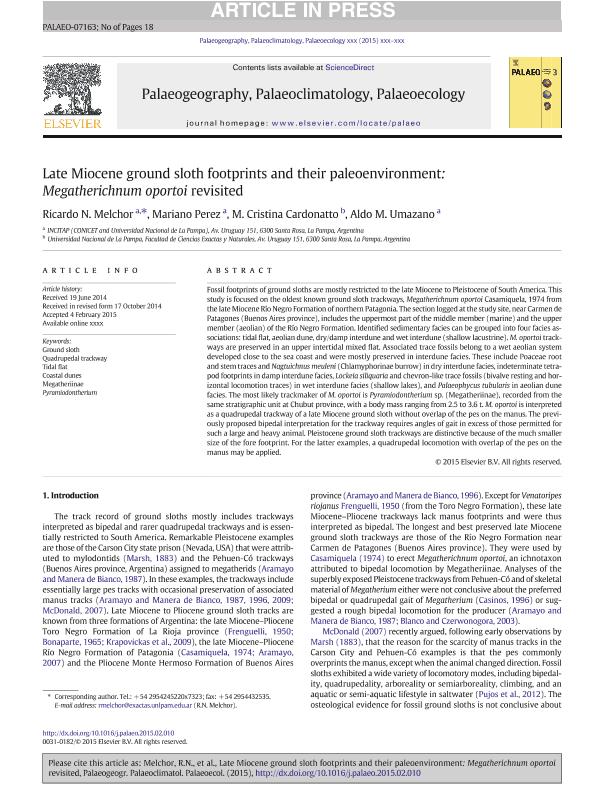Mostrar el registro sencillo del ítem
dc.contributor.author
Melchor, Ricardo Nestor

dc.contributor.author
Perez, Mariano

dc.contributor.author
Cardonatto, María Cristina

dc.contributor.author
Umazano, Aldo Martin

dc.date.available
2017-06-30T15:04:21Z
dc.date.issued
2015-12
dc.identifier.citation
Melchor, Ricardo Nestor; Perez, Mariano; Cardonatto, María Cristina; Umazano, Aldo Martin; Late Miocene ground sloth footprints and their paleoenvironment: Megatherichnum oportoi revisited; Elsevier Science; Palaeogeography, Palaeoclimatology, Palaeoecology; 439; 12-2015; 123-146
dc.identifier.issn
0031-0182
dc.identifier.uri
http://hdl.handle.net/11336/19252
dc.description.abstract
Fossil footprints of ground sloths are mostly restricted to the late Miocene to Pleistocene of South America. This study is focused on the oldest known ground sloth trackways, Megatherichnum oportoi Casamiquela, 1974 from the late Miocene Río Negro Formation of northern Patagonia. The section logged at the study site, near Carmen de Patagones (Buenos Aires province), includes the uppermost part of the middle member (marine) and the upper member (aeolian) of the Río Negro Formation. Identified sedimentary facies can be grouped into four facies associations: tidal flat, aeolian dune, dry/damp interdune and wet interdune (shallow lacustrine). M. oportoi trackways are preserved in an upper intertidal mixed flat. Associated trace fossils belong to a wet aeolian system developed close to the sea coast and were mostly preserved in interdune facies. These include Poaceae root and stem traces and Nagtuichnus meuleni (Chlamyphorinae burrow) in dry interdune facies, indeterminate tetrapod footprints in damp interdune facies, Lockeia siliquaria and chevron-like trace fossils (bivalve resting and horizontal locomotion traces) in wet interdune facies (shallow lakes), and Palaeophycus tubularis in aeolian dune facies. The most likely trackmaker of M. oportoi is Pyramiodontherium sp. (Megatheriinae), recorded from the same stratigraphic unit at Chubut province, with a body mass ranging from 2.5 to 3.6 t. M. oportoi is interpreted as a quadrupedal trackway of a late Miocene ground sloth without overlap of the pes on the manus. The previously proposed bipedal interpretation for the trackway requires angles of gait in excess of those permitted for such a large and heavy animal. Pleistocene ground sloth trackways are distinctive because of the much smaller size of the fore footprint. For the latter examples, a quadrupedal locomotion with overlap of the pes on the manus may be applied.
dc.format
application/pdf
dc.language.iso
eng
dc.publisher
Elsevier Science

dc.rights
info:eu-repo/semantics/openAccess
dc.rights.uri
https://creativecommons.org/licenses/by-nc-sa/2.5/ar/
dc.subject
Ground Sloth
dc.subject
Quadrupedal Trackway
dc.subject
Tidal Flat
dc.subject
Coastal Dunes
dc.subject
Megatheriinae
dc.subject
Pyramiodontherium
dc.subject.classification
Geología

dc.subject.classification
Ciencias de la Tierra y relacionadas con el Medio Ambiente

dc.subject.classification
CIENCIAS NATURALES Y EXACTAS

dc.title
Late Miocene ground sloth footprints and their paleoenvironment: Megatherichnum oportoi revisited
dc.type
info:eu-repo/semantics/article
dc.type
info:ar-repo/semantics/artículo
dc.type
info:eu-repo/semantics/publishedVersion
dc.date.updated
2017-06-29T13:59:15Z
dc.journal.volume
439
dc.journal.pagination
123-146
dc.journal.pais
Países Bajos

dc.journal.ciudad
Ámsterdam
dc.description.fil
Fil: Melchor, Ricardo Nestor. Consejo Nacional de Investigaciones Científicas y Técnicas. Instituto de Ciencias de la Tierra y Ambientales de La Pampa. Universidad Nacional de La Pampa. Facultad de Ciencias Exactas y Naturales. Instituto de Ciencias de la Tierra y Ambientales de La Pampa; Argentina
dc.description.fil
Fil: Perez, Mariano. Consejo Nacional de Investigaciones Científicas y Técnicas. Instituto de Ciencias de la Tierra y Ambientales de La Pampa. Universidad Nacional de La Pampa. Facultad de Ciencias Exactas y Naturales. Instituto de Ciencias de la Tierra y Ambientales de La Pampa; Argentina
dc.description.fil
Fil: Cardonatto, María Cristina. Universidad Nacional de La Pampa. Facultad de Ciencias Exactas y Naturales; Argentina
dc.description.fil
Fil: Umazano, Aldo Martin. Consejo Nacional de Investigaciones Científicas y Técnicas. Instituto de Ciencias de la Tierra y Ambientales de La Pampa. Universidad Nacional de La Pampa. Facultad de Ciencias Exactas y Naturales. Instituto de Ciencias de la Tierra y Ambientales de La Pampa; Argentina
dc.journal.title
Palaeogeography, Palaeoclimatology, Palaeoecology

dc.relation.alternativeid
info:eu-repo/semantics/altIdentifier/doi/http://dx.doi.org/10.1016/j.palaeo.2015.02.010
dc.relation.alternativeid
info:eu-repo/semantics/altIdentifier/urn/http://www.sciencedirect.com/science/article/pii/S0031018215000590?via%3Dihub
Archivos asociados
